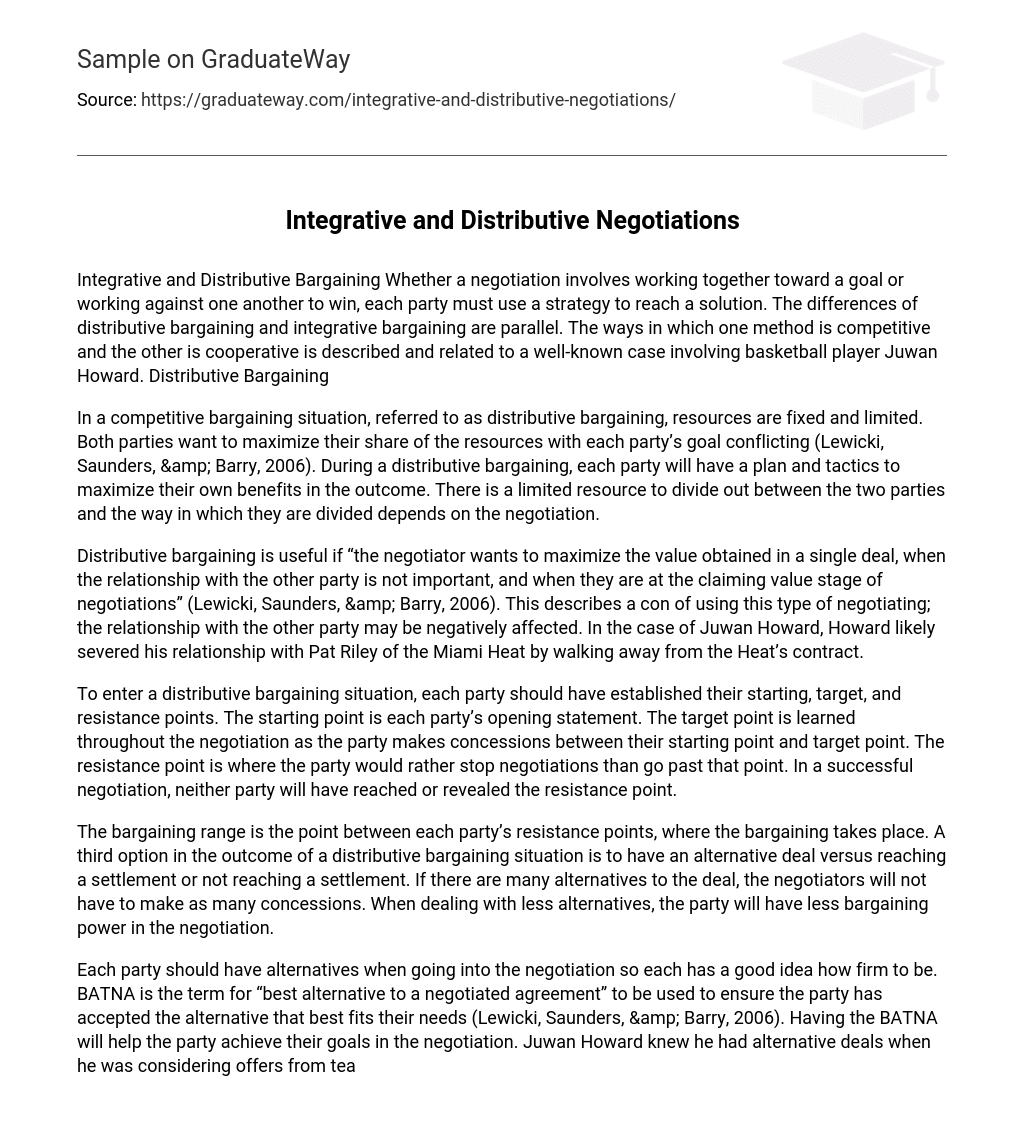Integrative Bargaining and Distributive Bargaining are distinct approaches in negotiation. In the distributive bargaining approach, parties adopt a competitive mindset to pursue their individual goals. Conversely, integrative bargaining promotes cooperation as parties collaborate towards a shared objective. An illuminating example of these two approaches is evident in the case of basketball player Juwan Howard.
In distributive bargaining, which is a competitive bargaining situation, both parties have fixed and limited resources. The goal of each party is to maximize their share of the resources, but their goals conflict with each other (Lewicki, Saunders, & Barry, 2006). In this type of bargaining, each party employs strategies and tactics to ensure their own benefits are maximized. The division of the limited resource between the two parties is determined by the negotiation process.
Distributive bargaining is advantageous in situations where negotiators want to maximize the value acquired in a single deal, especially when there is no significant connection with the other party and negotiations are at the claiming value stage (Lewicki, Saunders, & Barry, 2006). Nevertheless, this negotiating approach has a disadvantage as it can have a negative impact on the relationship with the other party. An illustration of this can be observed in Juwan Howard’s case where his decision to abandon their contract likely harmed his relationship with Pat Riley from the Miami Heat.
Engaging in distributive bargaining requires each party to identify their starting point, target point, and resistance point. The starting point is the initial statement made by each party, while concessions are made as negotiations progress towards the target point. On the other hand, the resistance point indicates the maximum limit at which a party prefers to end negotiations. In an effective negotiation, neither party will have reached or revealed their resistance point.
The bargaining range is the point at which negotiation occurs between the resistance points of each party. In a distributive bargaining situation, there is a third possibility wherein an alternative deal is sought instead of reaching a settlement or not reaching a settlement altogether. If there are multiple alternative options available, negotiators will need to make fewer concessions. Conversely, when there are limited alternatives, the negotiating party will have less bargaining power.
Both parties in a negotiation should have alternative options to consider in order to determine their bargaining position. The term “best alternative to a negotiated agreement” (BATNA) is used to refer to the alternative that best suits the needs of a party, ensuring they have accepted the most suitable option (Lewicki, Saunders, & Barry, 2006). By having a BATNA, a party can better achieve their goals in the negotiation process. For instance, Juwan Howard acknowledged that he had other offers from teams besides the Bullets, indicating that he had alternative deals to consider.
Howard’s objective of attaining a considerably elevated income was successfully reached by utilizing his expertise in negotiation. Integrative bargaining, unlike distributive bargaining which is characterized by competition, necessitates collaboration between parties to fulfill each other’s requirements. In integrative bargaining, it is crucial to comprehend the needs of the opposing party, promote an open flow of information, and discover mutually advantageous resolutions for both sides.
According to Lewicki, Saunders, and Barry (2006), the negotiation process involves promoting transparency in exchanging information, understanding the other negotiator’s genuine needs and goals, emphasizing shared similarities between parties, and finding mutually beneficial solutions that align with both parties’ objectives. To facilitate open communication, negotiators must openly share their goals and alternative options. Active listening and understanding are essential for creating a conducive atmosphere for open dialogue.
To ensure mutual benefit and reduce resistance, it is crucial for both parties to comprehend each other’s alternatives. The key lies in working together to find the optimal solution by understanding each other’s needs. While negotiators should remain resolute in their desires, they should also be receptive to flexibility, aiming for a satisfactory outcome that satisfies both sides. This cooperative negotiation approach was applied during NBA free agent negotiations involving Howard.
Howard’s team collaborated with the Heat to discuss and finalize his contract terms, and both parties reached a mutually beneficial agreement. However, the NBA intervened in this process. The Heat was willing to meet Howard’s conditions in order to bring him onto the roster. Although there was occasional competitiveness, both sides remained focused on their individual goals while considering the objectives of the other party. Integrative bargaining is only effective if both sides are cooperative and willing to work together. It is crucial for both parties to collaborate in order to achieve a resolution.
Using this method for negotiation is not ideal when dividing something up. Additionally, if one side does not comprehend the other side, conflict will arise without resolution. The integrative negotiation process encompasses four steps: identifying and defining the problem, bringing interests and needs to light, generating alternative solutions, and evaluating and selecting among them. Initially, the goal is to create value, followed by claiming the associated value.
Defining the problem is a challenging step in the process because it needs to be done in a detailed yet uncomplicated manner. Understanding the other party’s interests aids in comprehending their motivations for taking a stance on the topic. The third step involves both parties creating a list of alternative options to discuss and select from. In conclusion, negotiators in distributive bargaining have exclusive goals that are contrary to those of integrative negotiators.
In the NBA free agent draft, Juwan Howard utilized both methods of negotiation described in the text above. The text highlights that each method has its own differences and processes involved, but either method can be suitable depending on the circumstances.
References: Lewicki, R. J., Saunders, D. M., & Barry, B. (2006). Negotiation (5th ed.). Boston, MA: McGraw Hill. Lewicki, R. J., Saunders, D. M., & Barry, B. (2007). Negotiation: Readings, exercises, and cases (5th ed.). Boston, MA: McGraw Hill.





